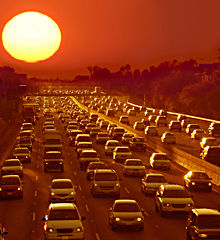
An urban heat island (UHI) is formed when parts of a city are significantly warmer than the outlying rural area due to the preponderance of concrete and asphalt surfaces that store heat during the day and release it at night. While urban heat islands are present in most large cities, the Phoenix metropolitan area has presented a special case for the study of this phenomenon because of its rapid growth over the last 30 years and the already high summertime temperatures experienced in the valleys of the Sonoran Desert.
The emergence and intensification of Phoenix’s UHI represents an important stressor on humans in the city. CAP researchers found that the UHI varies greatly in space, mirroring the physical heterogeneity of the urban landscape. Variations in amounts and distributions of soil, impervious surface, and vegetation in urban and suburban areas can both exacerbate or ameliorate the UHI. Superimposed on this are spatially variable demographic characteristics of the human population. As a result, extreme temperatures are distributed unevenly among neighborhoods, with minority, low-income, and elderly residents at greatest risk for exposure to high heat.
Suggested references:
Baker, L. A., A. J. Brazel, N. Selover, C. Martin, N. McIntyre, F. R. Steiner, A. Nelson, and L. Musacchio. 2002. Urbanization and warming of Phoenix (Arizona, USA): Impacts, feedbacks, and mitigation. Urban Ecosystems 6(3):183-203.
Harlan, S. L., A. Brazel, L. Prashad, W. L. Stefanov, and L. Larsen. 2006. Neighborhood microclimates and vulnerability to heat stress. Social Science & Medicine 63:2847-2863. Abstract
Jenerette, G. D., S. L. Harlan, A. Brazel, N. Jones, L. Larsen, and W. L. Stefanov. 2007. Regional relationships between vegetation, surface temperature, and human settlement in a rapidly urbanizing ecosystem. Landscape Ecology 22(3):353–365. Abstract
Ruddell, D. M., S. L. Harlan, S. Grossman-Clarke, and A. Buyantuyev. 2010. Risk and exposure to extreme heat in microclimates of Phoenix, AZ. Pp. 179-202 in P. Showalter and Y. Lu, eds., Geospatial Techniques in Urban Hazard and Disaster Analysis. Springer.
Sun, C-Y., A. Brazel, W. T. L. Chow, B. C. Hedquist, and L. Prashad. 2009. Desert heat island study in winter by mobile transect and remote sensing techniques. Theoretical & Applied Climatology 98:323-335. Abstract


